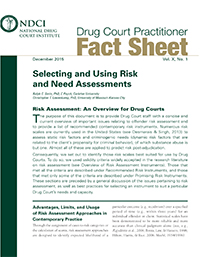Introduction
The Ohio Risk Assessment System (ORAS) is a suite of ten evidence-based offender risk and needs tools used by the Missouri Department of Corrections with every offender under its supervision. Furthermore, results from the ORAS are included in Sentencing Assessment Reports.
Therefore, criminal defense attorneys should understand how RNR assessments like the ORAS can impact their clients’ cases and lives. If not, they put themselves and their clients at a distinct disadvantage. Most importantly, the principles and practices behind offender risk and needs assessments provide a framework that criminal defense attorneys can use with their clients to get better outcomes and less severe consequences in their criminal cases.
The Ohio Risk Assessment System, like most offender risk and needs assessments used in the United States, follows the Risk-Need-Responsivity (RNR) Model of Offender Assessment and Rehabilitation. In this post, I will provide an overview of the RNR Model and how I use it in my own practice.
The Risk Need Responsivity Model of Offender Management
Research in offender risk and recidivism indicates there are eight central criminogenic risk domains which directly contribute to future criminal behavior. The Criminal History domain is static, meaning it cannot be addressed through treatment or other interventions. However, the other seven domains are considered dynamic, meaning they can be addressed through treatment interventions. Dynamic risk factors are also called Needs.
The Central Eight Criminogenic Risk Factors
- Criminal History
- Antisocial Personality Pattern
- Pro-criminal/Antisocial Companions
- Antisocial/Criminal Thinking
- Education/Employment Problems
- Family/Marital Problems
- Lack of Prosocial/Leisure Activities
- Substance Abuse
Ohio Risk Assessment System and Criminal Justice in Missouri
On June 1, 2019, the Department of Corrections implemented the Ohio Risk Assessment System (ORAS) to use with all offenders under its supervision. The DOC uses the results from the ORAS to determine treatment interventions and program placement. Furthermore, results of the ORAS should influence responses to offender behavior, such as incentives and sanctions. Finally, Missouri Sentencing Assessment Reports now include results from the ORAS-Community Supervision Tool (ORAS-CST).
from the Missouri Department of Corrections website
Ohio Risk Assessment System - Community Supervision Tool
The ORAS-CST contains 35 items with a possible score of 49 risk points. However, unlike the RNR Model, the ORAS-CST identifies individual risk factors across seven domains:
Criminal History (6 items)
Education, Employment & Finances (6 items)
Family and Social Support (5 items)
Neighborhood Problems (2 items)
Substance Use (5 items)
Peer Associations (4 items)
Criminal Attitudes and Behavioral Problems (7 items)
All individual risk factors in the Criminal History domain are static. However, the other domains have at least one dynamic criminogenic need and may have one or more static risk factors.
The total of all risk and need factors across all seven domains determines an offender’s overall risk to reoffend (recidivism). An offender’s level of supervision and services should match this risk to reoffend. For example, high-risk offenders should receive more intense supervision and interventions.
Finally, each domain has a risk score, representing the total of individual static risk and dynamic need factors identified in that domain. Treatment interventions should focus on dynamic needs identified in Moderate or higher risk domains. However, a moderate to severe substance use disorder should be addressed first.
Specific Responsivity Factors
In addition to static risks and dynamic needs, certain specific responsivity factors or Barriers may exist which prevent offenders from addressing their criminogenic needs. Therefore, barriers such as physical withdrawals, mental health, trauma, housing, transportation, health problems, and lack of motivation must be addressed if treatment or other interventions are to succeed.
In the RNR Model, RNR stands for Risk Need Responsivity. However, when addressing needs and responsivity barriers, read from right to left. First, address specific responsivity factors. Second, address criminogenic needs. Third, reassess for overall risk to reoffend. Successfully addressing a criminogenic need results in a statistically lower risk to reoffend. For more information, heck out the fact sheet from NDCI.
Level of Service: Case Management Inventory
After more than a decade volunteering on Missouri treatment courts, I became convinced that offender risk and need assessments were an important and useful tool I could use to help my clients live happier, more prosocial lives. Furthermore, I knew that addressing their needs and barriers would create mitigation circumstances I could use to argue for better dispositions in their cases.
Unfortunately, the Ohio Risk Assessment System is only given to felony defendants at or near the end of their criminal cases. Therefore, two years ago, I trained and certified on the Level of Service: Case Management Inventory (LS/CMI). The LS/CMI is a fourth generation RNR assessment comparable to the ORAS. With the LS/CMI, I can pinpoint areas my clients need to address, then recommend appropriate treatment interventions. For example, I can refer clients to substance and mental health professionals, education and employment resources, and prosocial leisure activities.
Moreover, by addressing their Needs and Barriers, my clients will give me a documented and persuasive argument to use during plea negotiations or at sentencing. Simply put, by addressing their needs and barriers, clients show they are taking responsibility for their actions, reduce the statistical probability that they reoffend, and show they can live a prosocial life in the community.
Conclusion
To summarize, the Missouri Department of Corrections evaluates every offender under its supervision with the Ohio Risk Assessment System. The ORAS identifies Needs and Barriers that an offender should address to reduce the likelihood of future criminal behavior. However, defendants are not evaluated until at or near the end of their felony criminal cases.
Because of training and experience with drug courts, I realized the importance of addressing needs and barriers to reduce future criminal behavior. Furthermore, addressing criminogenic needs and barriers can aim offenders in a prosocial direction, resulting in happier, more prosocial lives.
Therefore, over two years ago, I trained and certified on the LS/CMI, a validated offender risk and needs assessment comparable to the Ohio Risk Assessment System. In fact, the LS/CMI follows the RNR Model more closely than does the ORAS-CST.
In conclusion, even without administering a full risk and needs assessment, the structure of the RNR Model gives me a framework for developing powerful and persuasive sentencing mitigation arguments. Initially, I can triage my clients to identify low-hanging needs and barriers they can address while their criminal case is pending. Then, I can document their prosocial actions and behavior in addressing those needs and barriers to argue for better dispositions and less severe consequences in their criminal cases.
Please leave a comment below, or contact us here.



